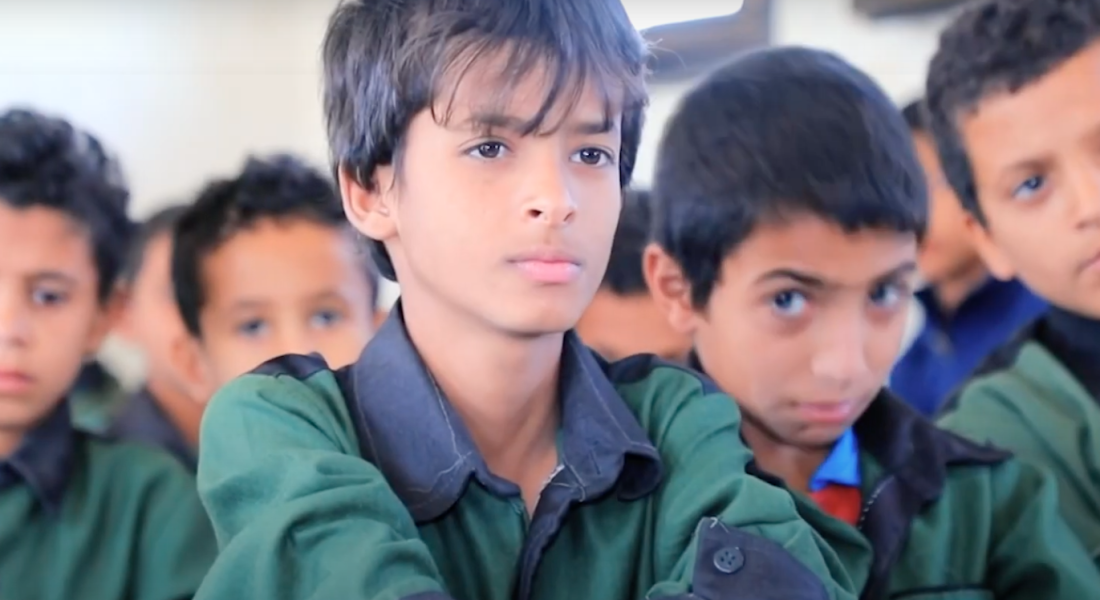Eman is a young Yemeni girl who is no longer able to play with her friends in the streets of her village in the district of Hays, south of Yemen’s western Al Hudaydah Governorate.
The little girl lost her right hand as a result of the explosion of a landmine planted by the Houthi militia in front of her house.
Landmine tragedies
Eman’s story summarises the tragedy of thousands of Houthi landmines victims in a country suffering from years of war.
Speaking to Project Masam, Eman described how she was walking out of her small house one morning when she stepped on a landmine. She lost consciousness.
After waking up in a hospital bed, the young girl discovered that she had lost her right hand, and that her body had been blasted by fragments.
In a soft voice, Eman said she no longer wanted to go to school because she didn’t know how to write without her right hand.
Eman is not the first victim, and she will not be the last. Many Yemeni children fall daily in separate landmine accidents, as landmines have been planted on main roads cities and tracks leading to villages, homes and farms.
Injuries and disabilities caused by landmines may differ, as some lose some of their upper or lower parts, but all the victims and their families suffer as a result of landmine accidents.
A high price
Between June 2014 and February 2022, the American Center for Justice found in its report Mines: the Blind Killer, that 429 children had been killed and another 723 children had been injured as a result of anti-personnel landmines, anti-vehicle landmines, naval mines or improvised explosive devices (IEDs) across 17 governorates.
The report highlighted how 75 per cent of the wounded victims had lost limbs and had become disabled or disfigured.
Children constitute a big percentage of landmine victims. According to a report by Doctors Without Borders/Médecins Sans Frontières (MSF) Trapped by mines published in January 2019, MSF’s field teams in the port city of al-Mukha, west of Taiz, had hospitalized and treated more than 150 civilians who were injured by landmines, IEDs and unexploded ordnance between August and December 2018.
The report indicated that one-third of those victims were children.
Meanwhile, the Yemeni Observatory on Landmines said “children are paying a high price because of the landmines planted by the Houthis and the unexploded ordnance from war remnants”.
During the first half of 2021, the Observatory said that it had documented the death of 14 children and the wounding of 21 others – most of them in the governorates of Al-Hudaydah and Taiz.
This had been previously confirmed by Save The Children, which stated that 33 children were killed and injured every month in 2019 in both Taiz and Hudaydah, which it considered the deadliest areas for children in Yemen.
An endemic
The United Nations’ Group of Eminent Experts on Yemen presented a report to the Security Council in December 2019.
The Group of Eminent Experts on Yemen said that they has documented 23 specific cases of civilian landmine victims in al-Bayda, Hudaydah, Shabwa, and Taiz including seven cases of wounded children and seven children who were killed.
In its annual 2020 report, the UN team said “the indiscriminate use of landmines and IEDs by the Houthis is endemic and systematic”.
Children are attracted to bright objects that they believe are toys – and there is evidence that the Houthis have produced landmines resembling household tools and other familiar shapes.
Deprivation
Houthi landmines have deprived Yemeni children of a safe and stable environment in which to grow up – effectively denying them of their basic right including education and healthcare.
With many unable to attend school, children and teachers’ displacement and without working parents, children are also forced to become breadwinners to support their families.
The Teachers’ Syndicate in Yemen revealed there are two million working children due to the war.
It further reported the Houthis’ role in the demolition of 44 teachers’ houses and leveling them to the ground using landmines in the governorates of Saada, Amran, Hajja, and Sanaa in December 2014.
While the report of the Civil Commission for the Victims of House Bombings documented that the Houthis had bombed 810 houses in 17 governorates between September 2014 and June 2020.
Eman and other children who were disabled because of explosions are among the most severely affected by landmines due to the harsh economic and living conditions their families have to endure or because of the psychological traumas linked to the incidents.
Disabled children and children with special needs account for a large percentage of people living with disabilities in Yemen – some 4.5 million, according to Amnesty International.
In its report Yemen: Excluded: Living with disabilities in Yemen’s armed conflict, Amnesty International said that those living with disabilities face a lack of support, as families are displaced.
War crimes
The Houthi militia has been manufacturing and planting landmines in Yemen since the beginning of the war against the Yemeni government in 2004.
During the first five years, it was estimated that two million landmines of different shapes, sizes, and targets were planted, including explosives that were produced from landmines and which were modified to be exploded by remote controls, electric circuits, or infrared rays.
Those explosives are internationally banned – the use of anti-personnel landmines is prohibited under the 1997 Mine Ban Treaty and could constitute a war crime. Yemen is signatory to the treaty.
In a 2021 report on the violations taking place in Yemen, Human Rights Watch found that the Houthis used anti-personnel landmines considering and constituted a violation of the treaty.
This was also confirmed by the Group of Eminent Experts on Yemen whose mission concluded in 2021, saying that the Houthis had widely used anti-personnel landmines, stressing that this “may amount to war crimes.”
This is one of the reasons that pushed the Arab Parliament to issue a resolution in July 2018, in which it considered that the indiscriminate targeting of civilians in Yemen are “war crimes and crimes against humanity and a threat to regional and international peace and security, affirming that the perpetrators must be prosecuted and brought to the International Criminal Court.”
Mine Action efforts
The Houthis are still extensively producing and planting landmines.
Project Masam is running against time, in order to remove these explosive threats.
The project includes 32 engineering teams distributed in eight Yemeni governorates starting from Shabwa in the east to Taiz, Hudaydah, and Hajja in the west.
Though the project uses advanced technologies and devices to clear landmines and its teams include foreign experts, deminers must double their efforts to keep up with the indiscriminate planting of new landmines without maps.

